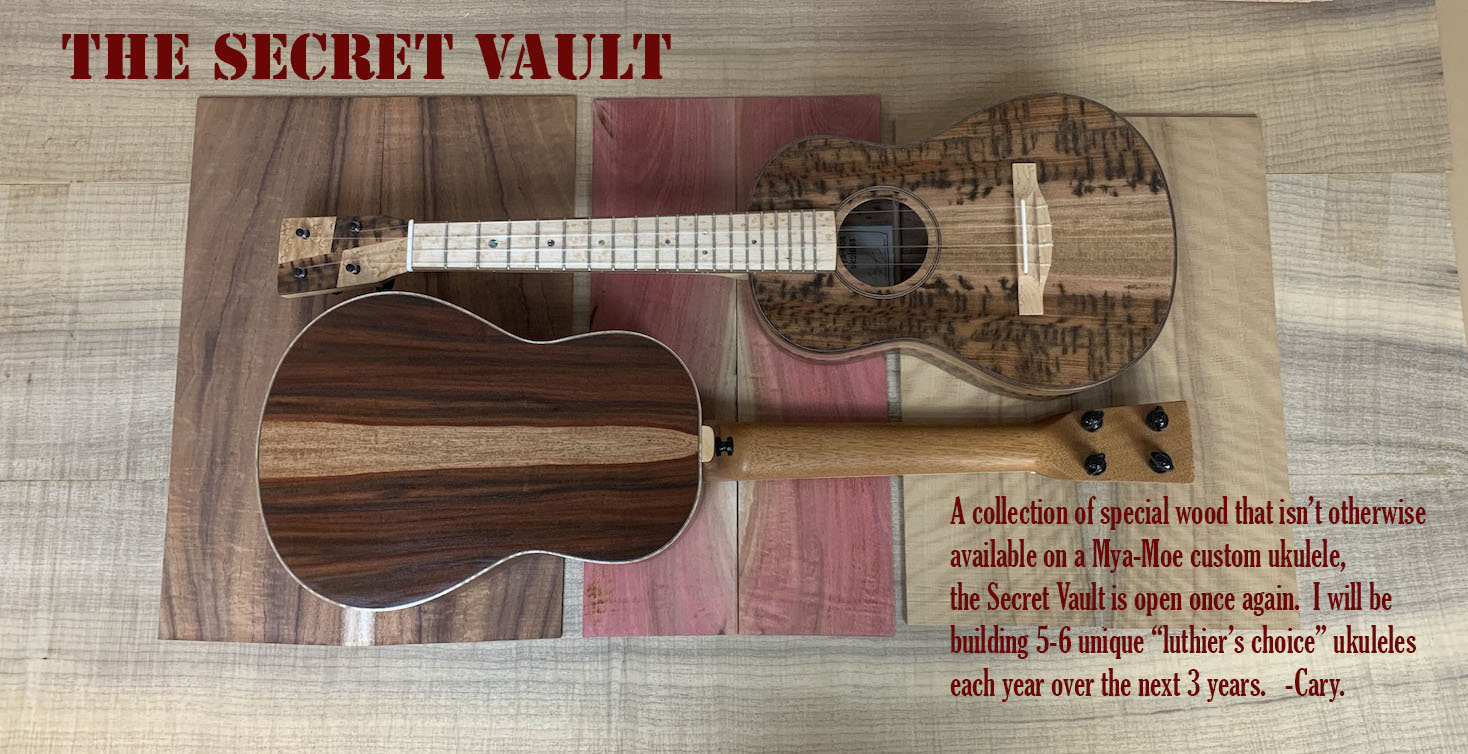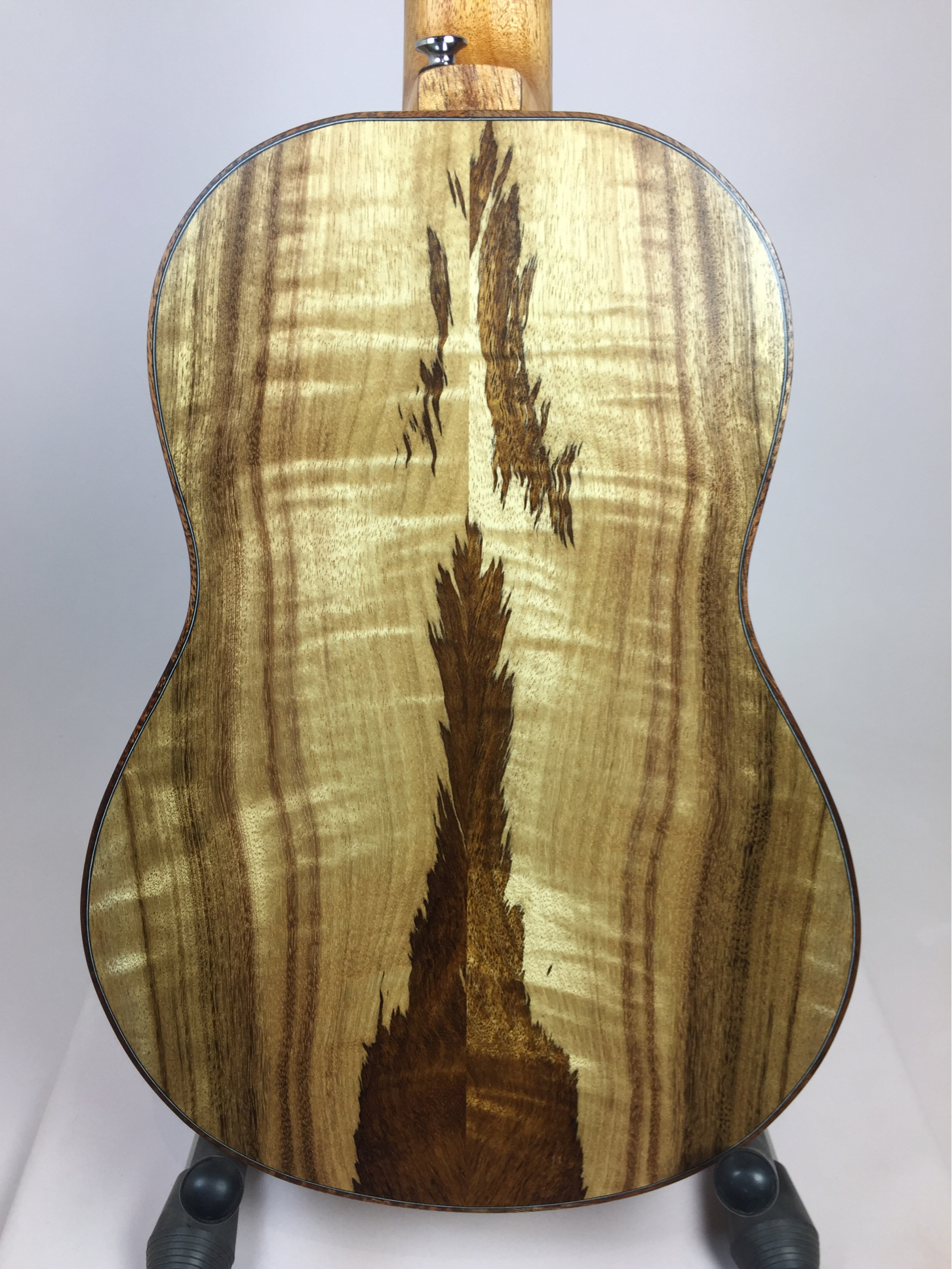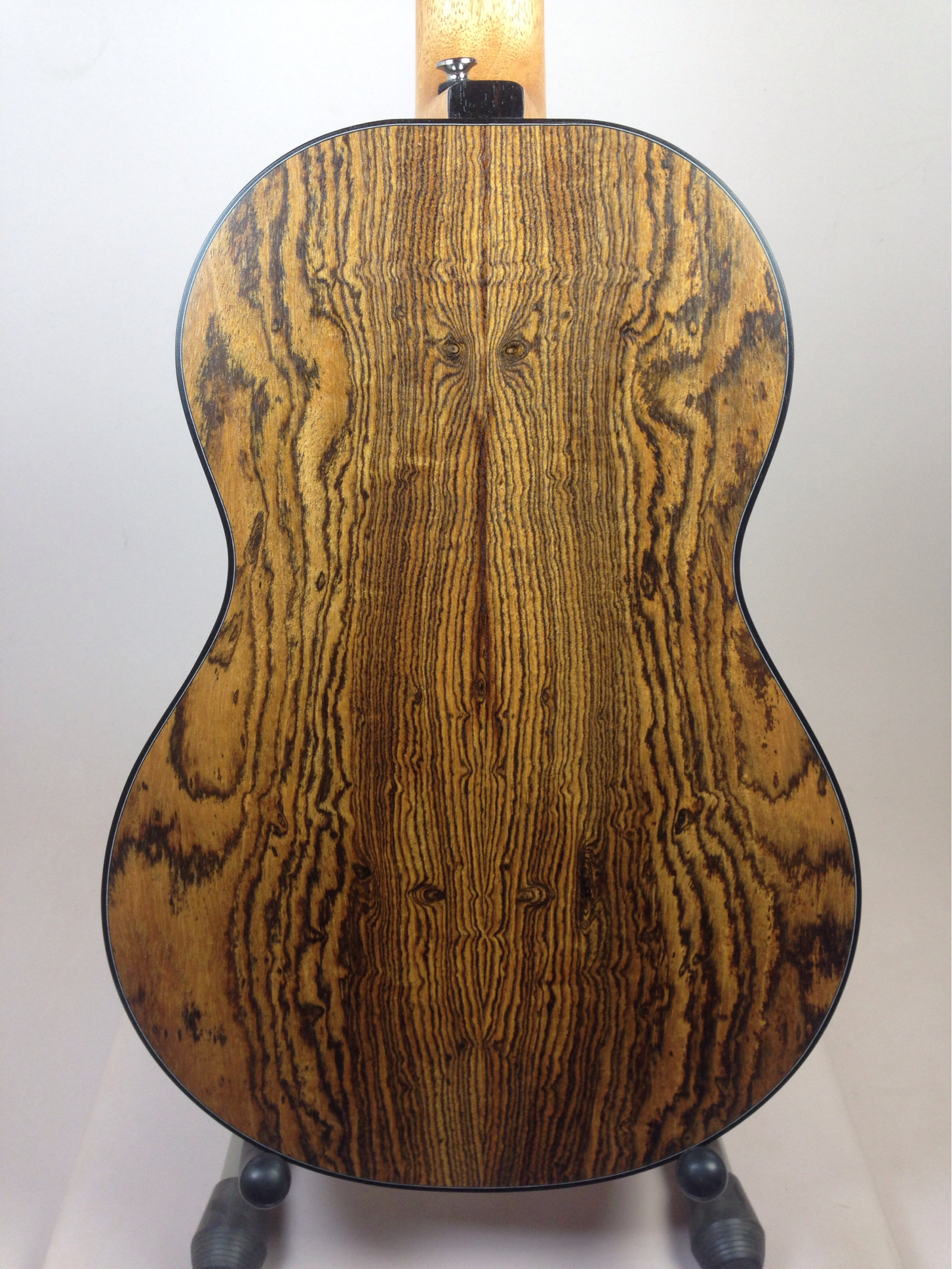Recent Additions to the Secret Vault 2021 - 2023
Curly Ovangkol / Torrefied Spruce See Instrument: #2798 AVAILABLE NOW |
Ovalgkol is a close relative to Bubinga and it certainly felt very similar as I worked with it. A very balaced tone that is perhaps a touch warmer than its cousin. Paired with a Torrefied Sitka Spruce top, this tenor arealdy has that extra volume and sustain you expect from well played and opened up ukulele. The icing on the cake is the French Polish finish using my personally mixed schellac from imported ultra blond flakes. It's a very laborious technique but the ultra thin finish pays off on the acoustic front. This Curly Ovangkol is the first Mya-Moe ukulele to receive the French Polish treatment. |
Pau Rosa See Instrument: #2769 |
Pau Rosa is a dense hardwood making it a great candidate for an ukulele back and sides when you are looking for a bright tone. The weight of the wood helps it maximize the reflection of the sound waves. This set of Pau Rosa have a vibrant color palette making it a easy choice for the latest addition to the Secret Vault Series. The Pau Rosa has been paired with an Incense Cedar top. This particular set of Cedar provided a warm tonal balance for the dense Pau Rosa back and plus a beautiful color match. |
Black & White Tenor Resonator See Instrument: #2751 |
A special Mya-Moe Resonator. The Tenor Resonator was launched over 14 years ago with a chrome coverplate. This instrument represents the first significant design update since then with the introduction of a solid wood coverplate using wood from the body layered on solid ebony. The Black & White ebony used for this resomator came from Char's wood shop and I've been saving it for a special build. The primary function of the coverplate on a resonator is to protect the underlying custom-spun cone which is doing the bulk of the acoustic work. As such, the overall tone of the resonator hasn't been impacted by the redesign and retains that loud, punchy voice of a Mya-Moe Resonator without being too "metallic". |
Waterfall Bubinga See Instrument: #2728 |
Bubinga comes from equitorial Afica and is sometimes referred to as African Rosewood. Bubinga is not a true rosewood, however is pocesses an excellent strength-to-weight ratio making it a superb candidate for the ukulele. This is the first and only Mya-Moe using Bubinga, but we wouldn't be surpised to see more luthiers embrace this tonewood. #2728 was paired with a straight-grain Western Red Cedar to produce a balanced, warm tone. This addition to the Secret Vault Series includes a slotted headstock with special Rubner Tuners featuring engraved black nickel and Ebony buttons. |
Spalted Makore See Instrument: #2708 |
Sometimes called West African Cherry, Makore has a bright tone that's very well balanced across the low, mid and high ranges. This set of Spalted Makore was inherited from Char Mayer and had been saved for the rebirth of the Secret Vault. It's the only Makore in the shop and we have no intention of finding more, so #2708 will be the only Mya-Moe built with this unique wood. Also unique to this instrument are the Rosewood buttons on the Rubner tuners as all other slotted headstock tuners used on Mya-Moe instruments use ebony buttons. This ukulele also features a custom signature headplate pairing the Spalted Makore with more Rosewood. A one-piece curly Port Orford Cedar top brings just the right touch of warmth to the bright Makore back. |
Milo See Instrument: #2669 |
A rare Hawaiian hardwood, Milo has a rich and deep red-ish/brown-ish hue. It's a much denser tonewood than it's Hawaiian neighbor, Koa, and so it also produces a brigher tone. When a customer asked if I could build a Milo Tenor, I was able to find a couple of very nice looking sets and went to work. I built one Milo tenore without giving much consideration to how hard to replace the Milo was. This is the final set of Milo that I have big enough for a tenor ukulele. As the first new Secret Vault ukulele built in three year, Mya-Moe #2669 leads the way for this new limited series. |
Tiger Myrtle See Instruments: #2673 |
I found this set of Tiger Myrtle and immediately had to have it! This isn't the Oregon Myrtle (umbellularia californica) that we feature here at Mya-Moe. This wood is similar yet completely different. It's Tasmanian Myrtle (nothofagus cunninghamii) and it looks and sounds equally good as its American namesake. The tone is slightly brigher than Oregon Myrtle and I adjusted the bracing slightly to account for the stiffness of the soundboard. The results were a wonderful balance between sustain and note clarity. |
Pink Ivory See Instruments: #2681 |
A popular choice in the initial Secret Vault Series, Pink Ivory, makes it's debut in the the new Secret Vault. I picked up this set on Char's advice, shortly after taking over Mya-Moe. I've been holding onto this Pink Ivory for almost 3 years, waiting for the right time to build with it. Since then, I haven't seen Pink Ivory available in sizes large enough for even an ukulele so I don't expect to be building with this rare South African hardwood again anytime soon. |
Launch of the Secret Vault 2015-2018
Cocobolo |
Cocobolo is a true Rosewood and while it's not impossible to find, it falls into the category of woods that are quickly becoming scarce. I found a source for this wood and stocked up with as much as I could afford, since it's also quite spendy. In the sets I acquired, there are some that we'd call "jaw-dropping" and those few found their way to my stash. Amazing patterns that make fantastic book matched plates. We paired it with a sinker Redwood top to make the first Secret Vault instrument - a deep, dark tenor with an equally deep dark voice. |
Pink Ivory |
Pink Ivory, also called Purple or Red, is an extremely dense, African hardwood. The Pink Ivory tree grows predominantly in Zimbabwe, Mozambique and South Africa. The tree is protected and sustainably maintained in South Africa, only felled by very limited permit. I've only seen pieces of Pink Ivory on wood turning supply websites and only in very small sizes. 3 years ago, I was lucky enough to run across 4 ukulele sets of this rare wood. The first tenor we made with a Port Orford Cedar top and this combination has yielded an amazing tone, certainly proving worthy to be part of the Secret Vault Series. |
Master Grade Koa |
What can I say about Koa? It was the wood used by early ukulele-makers because of it's local abundance and likely, it's beauty. We've made many Koa instruments over the years so it's no surprise that I've stashed a few spectacular sets away. I look back through the gallery and see many that would qualify, but these 2 are the last from my all-time favorite Koa board. |
Milo See Instrument: #2477 |
Once plentiful along the shores of Hawai'i, Milo is scarce now as shore-front properties have been cleared for houses & condominiums. Over the years, I have been able to get my hands on a few sets but this particular one is from the same tree as the first Natural Wonders Series instrument we ever made - Milo Tenor #241. I got 8 slices from my Koa supplier when we met in the early days of Mya-Moe. We built #241 and I've kept the second set, forever in my mind thinking we'd build it when we were planning to retire. So here we are... |
Blue Pond Myrtle |
Back in 2010 while visiting one of our wood suppliers, we found 3 billets of what he called Blue Pond Myrtle - sinker Myrtle from a tree that had been submerged in a pond for who knows how long, dredged up and dried. It looked pretty drab, gray & dull. Shortly after that, we made the first instrument
from it for Ben Lovett of Mumford & Sons. Working with it was interesting - it bends like a dream, the swamp speaks out when it's sanded and finish transforms it into a shimmer of blue, gray, green and khaki curls. It must be that the swamp has a song because the tone is soulful & full. We were in love. We built the second instrument as a Christmas present for Gordon's daughter, Jenny. While it was under construction, the Mumfords came by for a visit and while they were in the shop, they all signed it. In the following year, we build 11 more and while we still had a little left, we called the supplier to get more. None!! So, the rest of it went into my secret stash. I let a little of it go when we built our 1000th instrument. I'd intended to use the rest to build other commemorative ones but we decided to start this series & it seems like the perfect place for the remaining material. I have around 6 sets which will be used for tenors & super sopranos, so I can maximize the use of it. This one is precious! |
Chocolate Heart Myrtle |
As you can tell from cruising through our gallery of completed instruments, we love building from Myrtle. One of my wood suppliers introduced us to what he called Chocolate Heart Myrtle the very first time we met him. The patterns created when some of this wood is bookmatched are so interesting. Naturally, some of these have ended up in my stash. I labeled a few of them the "Butterflies" and another is a 1-pc top & back that are the remaining pieces from the board we used to make #500. So look for Myrtle to be well-represented! |
Black & White Ebony |
The drippy veins of black over the creamy maple-colored background in this wood make me think of a Salvadore Dali painting... or a Rorschach test! Eyes, bats, wings, faces - what do you see? This wood naturally makes it into the Secret Vault. As you would imagine, this variety of Ebony is just like it's silky black sister we use for our fingerboards & bridges - incredibly dense. It's not very easy to work with, being quite stubborn for bending and eating up sandpaper at an alarming rate. But it's wonderful when paired with a responsive top like Cedar, yielding a big, rich tone. Eye candy. Ear Candy. Yes, please. |
Bocote See Instruments: #1851 |
A lot of builders use Bocote. I only have one set of Bocote. I don't plan on getting anymore. We already offer so many wood options that it's hard to choose, so adding and stocking another isn't in the cards. So this set is in the Secret Vault because it's the only Bocote Mya-Moe we'll ever make. Don't get me wrong - it's a stunning set! But it is special because it's the only one. |
Pistachio See Instruments: #1845 |
Pistachio is an incredibly dense and sustainable hardwood. We have considered using it as an alternative fingerboard because of it's stiffness & durability. Aaron actually got this set of Pistachio from a potential supplier and since we aren't introducing new woods, we have decided to include it in the Secret Vault as another in the "only one Mya-Moe" category. You simply cannot believe the color and pattern in this book match! |
| Eucalyptus See instruments: #1941 |
Eucalyptus is in the same category as Bocote & Pistachio - I only have one set and there will only be one Mya-Moe Eucalyptus instrument ever made. Besides that, though, this one has a special place in my heart because I got it from my Koa supplier on our first visit to his shop. He suggested we use it to build ukuleles and we took this one set. It's pink-ish in color, beautifully curly and I've always thought I'd do a Valentine's instrument with it. So yes, I'm doing it and I'm including it in the Secret Vault! |


